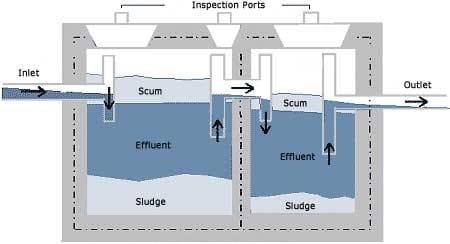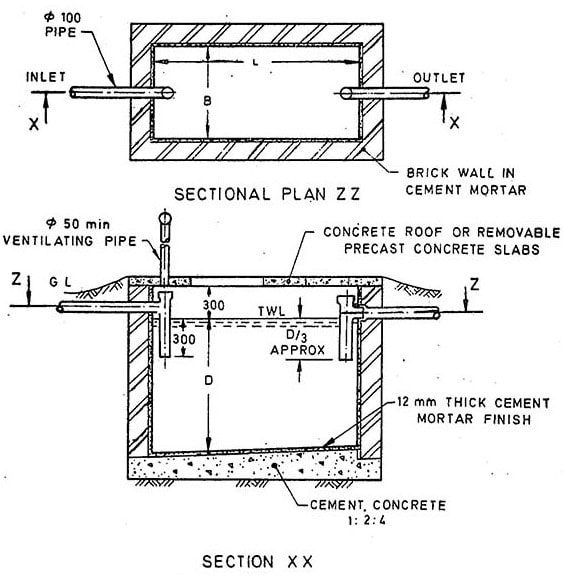Components and Design of Septic Tank Based on Number of Persons
What is Septic tank?
A septic tank can be defined as primary sedimentation tank with large detention time (12 to 36hrs against a period of 2hrs in an ordinary sedimentation tank).
In un-sewered rural and urban areas septic tanks are suitable for disposal of night soil. But sufficient water should be available as water is required for flow of the night soil from latrine to the septic tank and for proper functioning of the septic tank.
The size of the septic tank is so designed that the sewage is retained in the tank for 24hrs during which certain biological decomposition by the action of anaerobic bacteria takes place which liquefies and breaks the night soil leaving small quantity of soil which is known as sludge and settles at the bottom of the tank and clear water known as effluent flows out of the tank.
The effluent from the septic tank is usually disposed by absorption in the soil through soak pit, if no municipal drainage system is prevailing in the area. If municipal drainage line exists in the area, the effluent is discharged to the drain.
It is to be noted that disinfection agent such as bleaching powder, phenyl etc. should not be used in cleaning latrines as disinfectant entering the septic tank kills the bacteria growth as a result of which rate of biological decomposition is retarded.

Fig: Working of Septic Tank
Design of Septic Tank
The capacity of septic tank depends on number of users and interval of sludge removal. Normally sludge should be removed every 2 years. The liquid capacity of tank is taken as 130 liters to 70 liters per head. For small number of users 130ltr per head is taken.
A septic tank is usually provided with brick wall in which cement mortar [not less than 20cm (9 inch)] thick and the foundation floor is of cement concrete 1:2:4. Both inside and outside faces of the wall and top of the floor are plastered with minimum thickness of 12mm (one-half inch) thick cement mortar 1:3 mix.
All inside corners of septic tank are rounded. Water proofing agent such as Impermo, Cem-seal or Accoproof etc. is added to the mortar at the rate of 2% of the cement weight. Water proofing agent is to be added in similar proportion in to the concrete also for making floor of the tank.
For proper convenience in collection and removal of the sludge, the floor of septic tank is given a slope of 1:10 to 1:20 towards the inlet side. Which means that floor of the outlet side will be on the higher elevation than the floor at inlet side.
Dimensions of Septic Tank Components
i) Length, Width and Depth of Septic Tank
Width = 750mm(min)
Length = 2 to 4 times width
Depth = 1000 to 1300mm. (min below water level) + 300 to 450mm free board
Maximum depth = 1800mm + 450 mm free board
Capacity = 1 cubic meter (10 cubic feet) minimum
ii) Detention period
Detention period of 24hrs (mostly) considered in septic tank design. The rate of flow of effluent must be equal to the rate of flow of influent.
iii) Inlet and outlet pipes
An elbow or T pipe of 100mm diameter is submerged to a depth of 250-600mm below the liquid level. For outlet pipe an elbow or T type of 100mm diameter pipe is submerged to a depth of 200-500mm below the liquid level. Pipes may be of stone ware or asbestos.
iv) Baffle Walls of Septic Tank
For small tanks, RCC hanging type scum baffle walls are provided in septic tanks. Baffle walls are provided near the inlet. It is optional near the outlet.
The inlet baffle wall is placed at a distance of L/5 from the wall, where L is the length of the wall. The baffle wall is generally extended 150mm above to scum level and 400-700mm below it.
Scum being light, generally floats at the water level in the tank. Thickness of the wall varies from 50mm to 100mm. for large tanks lower portion are having holes for flow of sludge.
v) Roofing Slab of Septic Tank
The top of the septic tank is covered with a RCC slab of thickness of 75-100mm depending upon the size of the tank. Circular manholes of 500mm clear diameter are provided for inspection and desludging. In case of rectangular opening clear size is kept as 600X450mm.
vi) Ventilation Pipe
For outlet of foul gases and ventilation purpose cast iron or asbestos pipe of 50-100mm diameter is provided which should extend 2m (min) above ground level. Top of the ventilation pipe is provided with a mosquito proof wire mess or cowl.

Fig: Sectional plan ZZ shoes the typical layout of the septic tank. Section XX shows the Cross-Sectional detail of septic tank.
Example – Design of Septic Tank for 20 Users
Liquid capacity of the tank:
@120lts per user = 0.12 X 20 =2.4cum
Take liquid depth as 1.3meter.
Therefore Floor area of the tank = 24/1.3 = 1.85m2
Taking length as 2.5times the breath
L X B=1.85
2.5B X B = 1.85
B = Sqrt(1.85/2.5) = 0.86 say 0.9m
Therefore, the dimension of the tank is 22.5 X 0.9m
Suitable Sizes of Septic Tank Based on Number of Persons
Suitable sizes of septic tanks for use of 5, 10,15,20,50 persons are given in following table.
| No of users | Length L in m | Breath B in m | Liquid Depth in m | Liquid Capacity to be provided in m3 | Free Board in m | Sludge to be removed(m3) | Interval Cleaning |
| 5 | 1.5 | 0.75 | 1.0
1.05
| 1.12
1.18
| 0.3
0.3
| 0.36
0.72
| 1 year
2 year
|
| 10 | 2.0 | 0.9 | 1.0
1.4
| 1.8
2.0
| 0.3
0.3
| 0.72
1.44
| 1 year
2 year
|
| 15 | 2.0 | 0.9 | 1.3
2.0
| 2.3
3.6
| 0.3
0.3
| 1.08
2.16
| 1 year
2 year
|
| 20 | 2.3 | 1.1 | 1.3
1.8
| 3.3
4.6
| 0.3
0.3
| 1.44
2.88
| 1 year
2 year
|
| 50 | 4.0 | 1.4 | 1.3
2.0
| 7.3
11.2
| 0.3
0.3
| 3.60
7.20
| 1 year
2 year
|
Comments
Annual Home Maintenance Contract Dubai